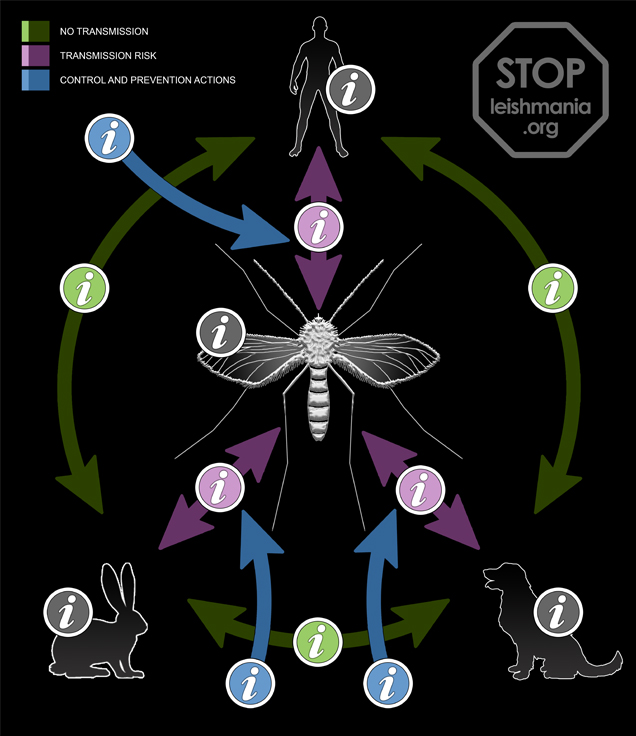Leishmaniosis prevention and control should include novel communication strategies that must be easily accesible and would include new advances in the knowledge of the disease. Recently, other animals different than dogs have been described as competent reservoirs of Leishmania, playing an important epidemiological role in recent outbreaks in Europe and Asia. At the moment, most of the information available is fundamentally devoted to humans and dogs, and there is no a global approach to the disease, taking into account all possible reservoirs.
Stopleishmania.org is an initiative of the VISAVET Health Surveillance Centre (UCM), the National Centre of Microbiology (ISCIII), the Animal Protection Centre (Madrid City Council) and the Directorate of Public Health (Regional Government of Madrid). This project launches the possibility of collaboration with other research centres, feeding the site with updated information on this disease.
Leishmaniosis in humans
Leishmaniosis are vector-borne diseases caused by obligate protistan parasites from the genus Leishmania. These parasites are transmitted to vertebrates and frequently hosted by canids and rodents; therefore the disease may be zoonoses, anthropozoonoses or anthroponoseses, although few species are strictly anthroponotic. In the Mediterranean basin the dog is considered as the main reservoir maintaining a peridomestic enzootia, with potential transmission to susceptible human populations. Recently, Leporidae (hares and rabbits) have been described as competent reservoirs of Leishmania, involved in the largest outbreak described in Europe until date.
More information about leishmaniosis in humans...
Leishmaniosis vector
These parasites are transmitted to vertebrates by the bite of infected female phlebotomine sandflies. Some 80 species and subspecies of phlebotomine sandflies have been described, and leishmania is transmitted by about 30. The genus Phlebotomus in the Old World, and Lutzomyia in the New World, are the proven transmitters of leishmaniasis.
More information about leishmaniosis vector...
Leishmaniosis in other animals
Leishmaniosis are vector-borne diseases caused by obligate protistan parasites from the genus Leishmania. These parasites are transmitted to vertebrates and frequently hosted by canids and rodents; therefore the disease may be zoonoses, anthropozoonoses or anthroponoseses, although few species are strictly anthroponotic. In the Mediterranean basin the dog is considered as the main reservoir maintaining a peridomestic enzootia, with potential transmission to susceptible human populations. Recently, Leporidae (hares and rabbits) have been described as competent reservoirs of Leishmania, involved in the largest outbreak described in Europe until date.
More information about leishmaniosis in other animals...
Leishmaniosis in dogs
Leishmaniosis are vector-borne diseases caused by obligate protistan parasites from the genus Leishmania. These parasites are transmitted to vertebrates and frequently hosted by canids and rodents; therefore the disease may be zoonoses, anthropozoonoses or anthroponoseses, although few species are strictly anthroponotic. In the Mediterranean basin the dog is considered as the main reservoir maintaining a peridomestic enzootia, with potential transmission to susceptible human populations. Recently, Leporidae (hares and rabbits) have been described as competent reservoirs of Leishmania, involved in the largest outbreak described in Europe until date.
More information about leishmaniosis in dogs...
Leishmaniosis no transmission
The parasite is mainly transmitted to human and animals through the bites of infected female phlebotomine sandflies. Leishmaniosis is not considered a food-borne zoonosis, so there is no risk in the consumption of animal carriers. There is also no contagion from direct contact with an infected animal. However, atypical transmission routes of have been described, including blood transfusion, sexual contact, needle sharing and also mother-to-child transmission.
More information about leishmaniosis transmission...
Leihsmaniosis transmission
The parasite is mainly transmitted to human and animals through the bites of infected female phlebotomine sandflies. Leishmaniosis is not considered a food-borne zoonosis, so there is no risk in the consumption of animal carriers. There is also no contagion from direct contact with an infected animal. However, atypical transmission routes of have been described, including blood transfusion, sexual contact, needle sharing and also mother-to-child transmission.
More information about leishmaniosis risks factors...
Leishmaniosis control and prevention in humans
Prevention and control of leishmaniosis requires a combination of intervention strategies because transmission occurs in a complex biological system involving the human host, parasite, sandfly vector and in some causes an animal reservoir host. Key strategies for prevention are listed below:
- Early diagnosis and effective case management reduces the prevalence of the disease and prevents disabilities and death.
- Vector control: helps to reduce or interrupt transmission of disease by controlling sandflies, especially in domestic conditions. Control methods include insecticide spray, use of insecticide–treated nets, environmental management and personal protection.
- Effective disease surveillance: Prompt data reporting is key to monitor and take action during epidemics and situations with high case fatality rates under treatment.
- Social mobilization and strengthening partnerships: Partnership and collaboration with various stakeholders and other vector-borne disease control programmes is critical.
More information about leishmaniosis control and prevention...
Leishmaniosis control and prevention in other animals
Prevention and control of leishmaniosis requires a combination of intervention strategies because transmission occurs in a complex biological system involving the human host, parasite, sandfly vector and in some causes an animal reservoir host. Key strategies for prevention are listed below:
- Early diagnosis and effective case management reduces the prevalence of the disease and prevents disabilities and death.
- Vector control: helps to reduce or interrupt transmission of disease by controlling sandflies.
- Effective disease surveillance: Prompt data reporting is key to monitor and take action during epidemics and situations with high case fatality rates under treatment.
- Control of animal reservoir hosts: is complex and should be tailored to the local situation.
- Social mobilization and strengthening partnerships: Partnership and collaboration with various stakeholders and other vector-borne disease control programmes is critical.
More information about leishmaniosis control and prevention...
Leishmaniosis control and prevention in dogs
Prevention and control of leishmaniosis requires a combination of intervention strategies because transmission occurs in a complex biological system involving the human host, parasite, sandfly vector and in some causes an animal reservoir host. Key strategies for prevention are listed below:
- Early diagnosis and effective case management reduces the prevalence of the disease and prevents disabilities and death.
- Vector control: helps to reduce or interrupt transmission of disease by controlling sandflies, especially in domestic conditions. Control methods include necklaces and anti-parasitic pipettes, use of insecticide–treated nets, environmental management.
- Effective disease surveillance: Prompt data reporting is key to monitor and take action during epidemics and situations with high case fatality rates under treatment.
- Social mobilization and strengthening partnerships: Partnership and collaboration with various stakeholders and other vector-borne disease control programmes is critical.
More information about leishmaniosis control and prevention...






